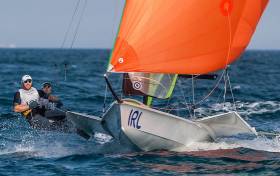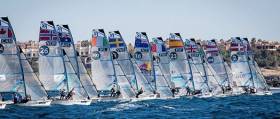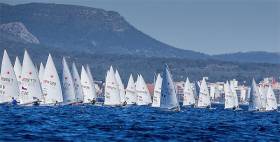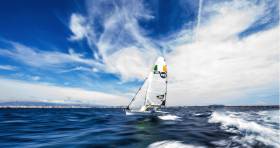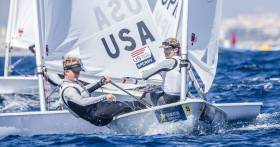Displaying items by tag: Andrea Brewster and Saskia Tidey
Seaton & McGovern Seventh, Brewster & Tidey 12th in Rio Skiffs
Ireland's Men's 49er Skiff Ryan Seaton and Matt McGovern from Ballyholme Yacht Club in Northern Ireland are seventh overall after nine sailed races in Rio. Dun Laoghaire's Andrea Brewster and Saskia Tidey are 12th after nine races in their 20–boat 49erfx fleet. It was the most frustrating day so far of the Olympic sailing competition with the wind refusing to play fair on Guanabara Bay.
49er Skiff
Perhaps inspired by French gold and bronze in the Windsurfing the previous day, Julien d'Ortoli and Noe Delpech fired their way up the rankings into fourth place after mastering the Copacabana course with two firsts and a third place. This puts the French just two points behind the third-placed Australians, reigning Olympic Champions Nathan Outteridge and Iain Jensen.
Meanwhile it's business as usual for the ever dominant Peter Burling and Blair Tuke (NZL) whose scores of 2,3,1 have opened up an 18-point lead over Erik Heil and Thomas Ploessel (GER). Even if the gold is beginning to get away from the Germans, they do at least have a healthy 15-point lead over the Aussies, with just three qualifying races remaining before the Medal Race.
Burling said, "We're pleased with three low scores, the boat was going really fast. We had some beautiful conditions for racing but got hit by a massive squall on the way in. It was maybe 45 or 50 knots.” Tuke added, "A south-west front came in and it went from 11 knots to more than 40 knots in the space of ten minutes.” Even the four-time World Champions capsized in the storm-force conditions. "We struggled to stay upright just with the mast up. Some massive waves out there, just happy to be back on shore,” said Burling, shivering and itching to get back to checking over the boat for any damage.
The Germans seemed to enjoy the mad ride in through the storm a little more than the Kiwis. "We ragged it quite fast on the way in,” said Heil. "But what lucky timing. Just after the last guy came across the finish line, the breeze came in 130 degrees from the other side, and with massive force. Even with just the mast up and no sails, we still needed to get on the trapeze to stop the boat tipping over. We have some boat work to do, we have damaged the sails, we have to check the mast.”
Noe Delpech was barely thinking about what a good day he'd had after getting ashore - just happy to be in one piece. "We had three good starts and are very happy with our speed and strategy today. But then there was the wind that arrived straight afterwards. We capsized many times. The mainsail went flying through the air and it fell in the water but our coach managed to save it before we lost it. We had a bad last hour on the water. The sails are not in great condition but I think we are OK mostly.”
Delpech was pleased to have closed in on the podium, but like all Olympic sailors never likes to get ahead of himself. "We are two points behind the bronze medal position, so yes, for sure we can start thinking about the options to get a medal, but we have still three important races to do tomorrow. We just go race by race.”
The Skiffs will have to work quickly with another three races scheduled for tomorrow which looks to be a busy day. The Laser, Laser Radial, Finn and Nacra 17 will all have their Medal Race due to the postponements from today.
Women's Skiff – 49erFX
Tamara Echegoyen and Berta Betanzos (ESP) fired two bullets from today's three races on the Niterói course moving the reigning World Champions to the top of the scoreboard. Behind them are two former World Champion crews, Alex Maloney and Molly Meech (NZL) who are four points behind the Spanish in second, and Martine Grael and Kahena Kunze (BRA) just one point behind the Kiwis in third overall.
Although previous overnight leaders Jena Hansen and Katja Salskov-Iversen (DEN) scored a second in the last race of the day their earlier scores of 9,16 have hurt the Danish team who are now fourth overall. However, the Danes are only nine points off the lead and there are still three more qualifying races scheduled for Tuesday before Thursday's Medal Race.
Echegoyen, the London 2012 Olympic Champion in match racing, commented, "We are very happy, we have sailed very well today. It was very important to be very open minded, to be able to adapt ourselves to what was happening. We were well prepared for today's three races, both in terms of understanding the conditions with our meteorologist and also regarding the tactics.
"In the two first races it was clear where to go, but the third one was really crazy and we just sailed with the wind shifts. It has been a good day, but also quite difficult, we have had to work a lot. These results give us the confidence to keep on going in this way. Now we are leading but we are all very close on points. Still three races and the Medal Race ahead, so we have to go step by step and keep on going.”
Seaton & McGovern In Top Five At Half–Way Stage of 49er Regatta, Brewster & Tidey Drop to 12th in 49erfx
Ballyholme's Ryan Seaton and Matthew McGovern are fourth overall at the halfway stage of the Men's Skiff 49er competition and Dun Laoghaire's Andrea Brewster and Saskia Tidey are 12th in the women's 49erfx after a demanding four race schedule yesterday.
Erik Heil and Thomas Ploessel (GER) were flying in the medium winds on the Aeroporto course in the Men's 49er. A race win at the start of the day combined with some other top five scores has brought the Germans to just three points off the lead, still held by Peter Burling and Blair Tuke (NZL). Heil and Ploessel have a 15–point lead over the chasing pack who are tightly bunched on points, with the best of the rest being third-placed Danish team of Jonas Warrer and Christian Peter Lübeck who won the third race of the day. Defending Olympic Champions Nathan Outteridge and Iain Jensen (AUS) started the day well with a second place but are still struggling to fire on all cylinders and sit in sixth overall at the half–way point of the qualifying series.
Burling commented, "We didn't feel like we sailed that well but to come away with four low scores was good. You only had one shot to get it right today and if you didn't, it was hard to fight back through." Tuke added, "It's already the halfway stage of the fleet racing and with four races today it was a big chunk of the fleet racing. The results aren't as pretty as yesterday but we're really happy with things."
Heil was happy to be in second place but did not consider the 15-point gap to third to be significant, not in Rio. "These are the most difficult conditions in the world. We saw in the Laser class they had 25 knots with three-metre waves, and then shifty races in light wind on the Sugarloaf course. It can't be more difficult than here in Rio, but we love the challenge."
In the women's 49erfx, it was an inauspicious start to the Danish campaign for a medal in the Women's Skiff in the first race on the previous day, when Jena Hansen and Katja Salskov-Iversen were UFD disqualified for breaking the start line too soon. However, they have since made amends with four second places and a fourth, catapulting the Danes to the top of the 49erFX tree. Tied in second overall are two former World Champion teams, Martine Grael and Kahena Kunze (BRA) and Alex Maloney and Molly Meech (NZL). Meech will be buoyed by having seen her brother move into third place overall before the Laser Men's Medal Race in two days' time. The 2016 and 2015 World Champions, representing Spain and Italy respectively, hold fourth and fifth overall at the halfway stage of the 49erFX qualifying series.
Grael commented, "It has been a very good day. The Danish also sailed very well, really consistent. We are happy to be in the fight. We know that we have a good speed and we can recover when we don't start well. Now we are looking forward to a rest day and we're looking forward to racing outside with the wind and the waves."
Olympic Sailing Team – Two Months to Improve Before Rio
After a weekend of poor Irish performances at the British round of the Sailing World Cup, the Irish Sailing Association has acknowledged results from Weymouth were 'far from ideal'.
The Sailing World Cup on the Dorset coast, billed as the 'final opportunity for sailors to lay down a marker before the Rio 2016 Olympic Games', was attended by 380 Olympic sailors from 44 nations.
Men’s skiff sailors Ryan Seaton and Matt McGovern from Belfast reached the medal race final which they led for its entirety before sailing the wrong course to the finish line.
London 2012 veteran Annalise Murphy, Ireland’s most successful sailing athlete in the last 30 years, had one of her most disappointing results of the season when she placed 34th in the 39–strong Laser Radial fleet. Murphy has been concentrating on preparations for her second appearance at the games but the Rio venue offers much lighter winds to four years ago when she narrowly missed a podium result.
Andrea Brewster and Saskia Tidey in the women’s skiff placed last in the 49erFX event.
“We have two months to focus on the things we can improve before starting the Olympic regatta in Rio', Team Manager James O'Callaghan said yesterday.
Men’s single-hander Finn Lynch, the youngest ever Irish helm to be selected for Team Ireland did not take part in the regatta due to training-camp commitments in Croatia.
The 49er pair have one further regatta at Kiel Week in Germany later this month before final preparations begin for their second Olympic appearance at Rio 2016 in August.
The first race in the Rio 2016 regatta begins on Monday 8th August when Murphy and Lynch begin their respective events.
A facebook campaign update from the 49er crew:
'Results not what we had planned for but valuable time on the water nevertheless' is the ISA conclusion from a mixed bag of results posted by the Olympic Sailing Team in Weymouth this weekend. On the eve of the Rio Olympics, there is at least some consolation that Northern Ireland 49er pair Ryan Seaton and Matt McGovern are through to today's medal race final.
By virtue of winning the last race of four sailed yesterday, the Belfast Lough duo qualified for today's medal race. (Watch race live here at 13.50)
In the Laser Radial, the National Yacht Club's Annalise Murphy finished 34th, one behind Howth's Aoife Hopkins in the 39–boat class. Andrea Brewster and Saskia Tidey were 15 from 15 in the 49erfx womens skiff.
Although this 2016 edition of the Weymouth World Cup was a bit of a light air wash–out, expect competition to be a whole lot tougher in similar conditions in Rio in just 54 days time.
Paddy Power Bookmaker Offers Odds on Olympic Sailors
Paddy Power Bookmaker is offering odds (scroll down the page) on Ireland's medal chances at this Summer's Olympic regatta. 49erfx Andrea Brewster and Saskia Tidey are 60/1. Ryan Seaton and Matt McGovern are 100/1, according to the bookie.
The bookmaker has so far not offered odds on either of Ireland's single–handers but this may change shortly with yesterday's confirmation of Finn Lynch as the last member of this year's Olympic sailing team.
Annalise Murphy, fourth in London (Ireland's best result in 32 years), has said eight radial sailors have potential to wn in Rio (including herself) so it will be interesting to see what the bookie offers on the Irish solo star.
The Olympic regatta starts in the first week of August.
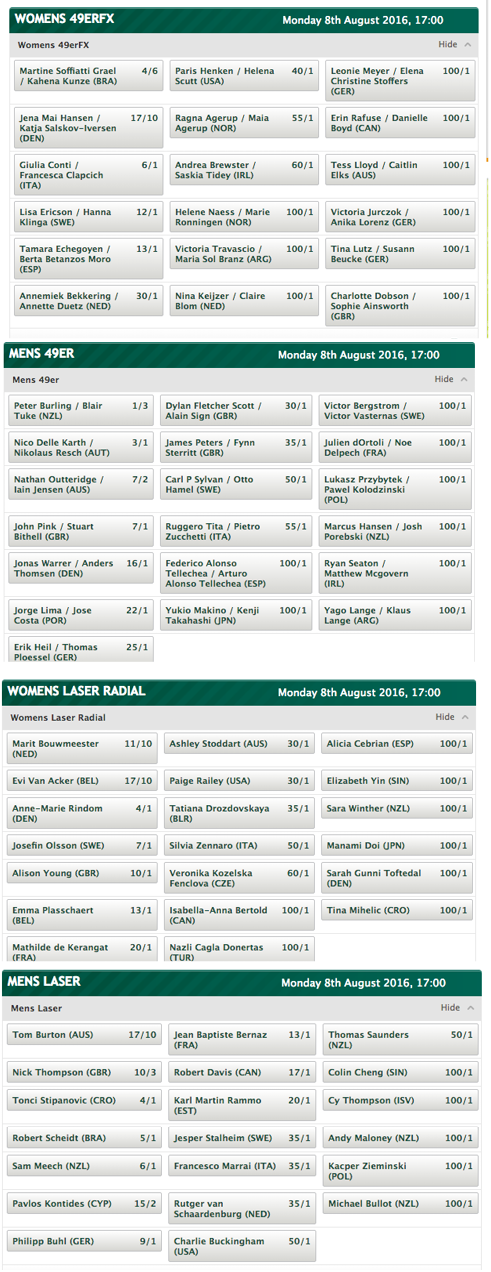
Northern Ireland Sailors Have the Edge in Palma
Belfast's James Espey had an eighth and a tenth in the silver fleet of the Trofeo Princesa Sofia today to regain the lead in the Irish trial for the mens Laser berth in Rio. His main rival Finn Lynch suffered a 37th place in the morning race after a difficult first leg. He went on to place 14th this afternoon but not before the Royal Ulster sailor had edged ahead once more, this time with an 18-point lead.
Northern Ireland sailors also performed well in the 49er skiff, Ryan Seaton and Matt McGovern moved back up the standings in the 49er skiff class to hold joint first place overall.
Although the pair had a shaky start to the four-race day with a 15th place, they went on to deliver a 5-3-8 score. The Belfast lough pair have another four races to maintain their standing for what could be a well–earned podium on Saturday afternoon.
The moderate to fresh winds that were initially accompanied by a thick fog bank that delayed racing and saw another move in the snakes and ladders game for the Irish selection trials in the Laser class.
In the 49erFX skiff event, Providence Team IRL's Andrea Brewster and Saskia Tidey rounded off a difficult day with a solid fifth place, their best of a week that marks their return to competition after an injury enforced break.
Tomorrow (Friday) is the last day of racing in the finals round and the top ten boats in each of the 10 Olympic classes racing will qualify for the medal races on Saturday. As 49er class front-runners for most of the week, Seaton and McGovern will be the only Irish crew interest on Saturday.
Finn Lynch Leads But Irish Laser Olympic Trial Far From Over
Sunny Palma laid on some of its best conditions for the third day of the 47th Trofeo Princesa Sofia IBEROSTAR today but it all started with a lengthy delay as a weak south-westerly eventually gave way to a moderate southerly with winds from 10-16 knots and great sailing conditions.
Dublin's Finn Lynch posted a marginally better overall score for the day over London 2012 rep James Espey as the pair fight it out to decide the Rio 2016 nomination.
With the three Irish Lasers racing in the Silver fleet, Lynch had a consistent sixth and a fifth. Espey had a ninth and a third to finish the day six points behind his rival for the sole Rio place. A reminder that the contest could yet be a three-way affair came from Baltimore's Fionn Lyden who won the first race of the day but followed this with a 32nd place and trails Lynch and Espey by almost 20 places.
Kinsale’s Darragh O’Sullivan had a fifth and a second place in the Laser class Bronze fleet where he is a single point off the podium with two days of racing left.
The morning’s calm conditions delayed the skiff classes racing until even later in the day but the opening race for the women’s 49erFX saw Providence Team IRL's Andrea Brewster and Saskia Tidey suffer their worst result of the series so far with a back of the fleet 30th place. However, as the breeze freshened for the second race the pair recovered form to place 14th and they lie 19th overall. Two days of racing remain to make up the 20-point difference for a place in the medal race final on Saturday.
The men’s skiff event had an even longer wait ashore as the wind barely reached the minimum strength for racing conditions. Ireland’s Ryan Seaton and Matt McGovern placed eighth in the only race of the day and lie fourth overall in the 49er class to look good for the medal race on Saturday.
After two days of light winds, tomorrow’s forecast is for fresh to strong gusty winds on the Bay of Palma for the penultimate day of fleet racing at the regatta.
Leading Results:
470 Men: 1.- Mathew Belcher/ Will Ryan (AUS): 5pts, 2.-Stu McNay/Dave Hughes (USA): 19, 3.-Jordi Xammar/Joan Herp (ESP): 20; 470 W: 1.- Fernanda Oliveira/Ana Barbachan (BRA): 7pts 2.-Afrodite Kyranakou/Anneloes Van Veen (NED): 16 3.- Anne Haeger/Briana Provancha (USA) : 20'
49er M: 1.- Diego Botín/Iago López (ESP):15pts, 2.- Nico Delle/Nikolaus Resch (AUT): 18, 3.- Erik Heil /Thomas Plossel (ESP): 20; 49er FX W: 1.-Annemiek Bekkering/Annerre Duetz (NED): 25pts, 2.- Jena Mai Hansen/Katja Steen (DEN): 27, 3.-Charlotte Dobson/Sophie Ainsworth (GBR): 47.
FINN: 1.- Josh Junior (NZL): 15pts, 2.-Giles Scott (GBR): 19, 3.- Pieterjan Postma (NED):24pts:
LASER STANDARD: 1.- Andrew Maloney (NZL): 18pts, 2.- Tonci Stipanovic (CRO): 25, 3.- Kristian Ruth (NOR): 25pts. LASER RADIAL: 1.- Anne-Marie Rindom (DEN): 16pts 2.-Evi Van Acker (BEL):18, 3.- Tuula Tenkanen (FIN):20.
NACRA 17, 1.-Billy Besson/Marie Riou (FRA): 23 2.- Vittorio Bissaro/Silvia Sicouri (ITA): 55, 3.- Paul Kohlhoff/Carolina Werner (GER): 56.
RS: X M: 1.- Tom Squires (GBR): 7pts 2.-Vyron Kokkalanis ((GRE): 10, 3.- Pawel Tarnowski(POL): 13. RS:X W: 1.- Olga Maslivets (RUS): 8pts, 2.- Charline Picon (FRA):): 17, 3.- Marina Alabau (ESP): 17.
Invited Classes: 2.4M: 1.- Helena Lucas (GBR): 3pts, 2.- Bjornar Erikstad (NOR): 7, 3.- Lasse Klotzing (GER): 8. Dragon: 1.-Lady Tati (POR): 3 2.-Convergens (RUS): 7 3.- Young Tigger (ESP): 10
Palma Silver Fleet for Irish Laser Sailors Contesting Rio Berth
None of the Irish contenders for the mens Laser berth slot have made the gold fleet cut today at the important Trofeo Princesa Sofia Regatta in Palma. The result, however disappointing in the build up to Rio, intensifies the three way Irish Olympic test underway in Palma Bay where there has been a change in the trials lead.
If day one of the regatta yesterday proved a straighforward boatspeed day in moderately brisk breezes, Tuesday's races today were much more about being in the right place, in the best pressure as much as possible. 800 boats are competing and 13 Irish sailors are in Palma but the Irish mens Laser trial is the focus of attention. The three contenders, from Dublin, Cork and Belfast, remain neck and neck.
Finn Lynch, the young National Yacht Club sailor who has made no secret of his cash–strapped campaign has emerged as the leading Irish boat overall after a lighter winds this afternoon. Lynch had a fifth in the opening race followed by a 23rd to leave him 52nd overall in the 152-strong fleet. Just two points stood between him and the cut for the Gold fleet that starts racing tomorrow.
Now in the Silver fleet, Lynch will keep a keen eye on Northern Ireland's James Espey who had a 20th and a 22nd yesterday and he dropped to 62nd overall, crucially five points behind Lynch. A 13th yesterday for Fionn Lyden of Baltimore was enough to get him into the Silver fleet so it is still anyone's guess who will be Ireland's rep in Rio, a race that looks set to go right down to the wire. The third and final selection trial is in Mexico in May.
Finn Lynch campaign video
Northern Ireland 49er Loses Overall Lead
In the 49er Skiff, although Ryan Seaton and Matt McGovern have lost their overall lead from day one they are joint second. A second and a third keep the Belfast pair on course for Saturday’s medal race final.
It was a different story unfortunately, for Rio qualified Andrea Brewster and Saskia Tidey in the 49erFX skiff. After a consistent top ten opening day, the Dun Laoghaire pair had a more challenging day and results in the 20s leave them in 15th overal from 27.
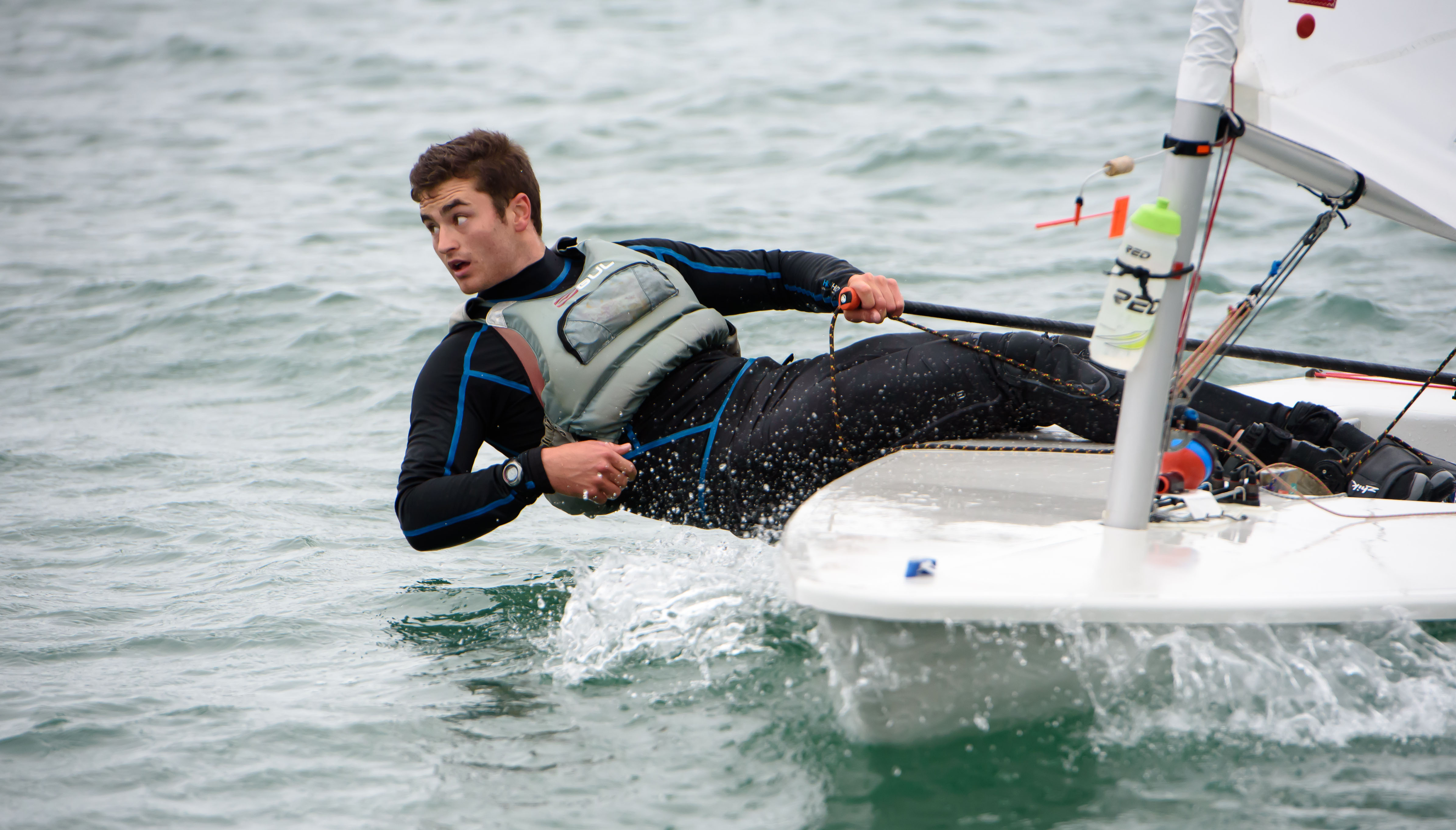
Darragh O’Sullivan Photo: Bob Bateman
Other Irish boats competing amongst the 800–plus fleet on the Bay of Palma, Kinsale's Daragh O’Sullivan is racing in the Laser Standard class and lies 117th overall.
In the 49er class, Robert Dickson and Seán Waddilove completed all three races yesterday in their debut at Palma and are 63rd overall. Mark Hassett and Oisin O Driscoll are close behind in 65th place.
Finn sailor Oisin McClelland from Donaghdee in County Down is racing in the Finn single-handed dinghy and lies 39th overall in his 74-boat class.
The result table toppers in the Men's 470 and the Laser Radial classes both count all first places - though both Olympic medallists Mat Belcher, and crew Will Ryan of Australia and Evi Van Acker discard their one bigger score, albeit a third and sixth respectively.
New Zealand's singlehanders are showing well so far. Josh Junior and Andrew Maloney now lead the Finn and Laser classes respectively after today and Sarah Winter, counting 2,2,7 to date, is fourth in the Laser Radials.
In the Laser Men's fleet Andy Maloney leads Norway's Kristian Ruth and the USA's Charlie Buckingham. Ruth is part of a strong Norwegian squad who have trained this winter on the Bay of Cadiz with 1996 Olympian Anton Garrote.
Despite the short postponement this morning the regatta schedule is pretty much on course. Three races were sailed for the 49ers, RS:X and Nacra 17s while the other classes completed two.
470
1. Mathew Belcher/ Will Rya, AUS, 3 points
2. Stu Mcnay/Dave Hughes, USA, 5
3. Anton Dahlberg/ Fredik Bergstrom, SWE, 6
470 Women
1. Amy Seabright/Anna Carpenter, GBR, 4
2. Fernanda Oliveira/Ana Barbachan, BRA, 4
3. Annika Bochmann/Marlene Steinherr, GER, 8
49er
1. Nico Delle/Nikolaus Resch, AUT, 11
2. Diego Botín/Iago Lopez, ESP, 14
3. Ryan Seaton/Matt Mcgovern, IRL, 14
49 FX
1. Jena Mai Hansen/Katja Steen, DEN,10
2. Annemiek Bekkering/Annerre Duetz, NED, 16
3. Martine Grael/Kahena Kunze, BRA, 17
Finn
1. Josh Junior, NZL, 9
2. Giles Scott, GBR, 15
3. Pieterjan Postma, NED, 15
Laser
1. Andrew Maloney, NZL, 5
2. Kristian Ruth, NOR, 7
3. Charlie Buckingham, USA, 8
Laser Radial
1. Evi Van Acker, BEL, 3
2. Alison Young, GBR, 8
3. Tuula Tenkanen, FIN, 10
NACRA
1. Billy Besson/Marie Riou, FRA, 11
2. Paul Kohlhoff/Carolina Werner, GER, 25
3. Thomas Zajac/Tanja Frank, AUT, 26
RS: X Men
1. Tom Squires, GBR, 4
2. Vyron Kokkakanis, GER, 5
3. Andreas Cariolou, CYP, 8
RS:X Women
1. Olga Maslivets, RUS, 4
2. Lilian De Geus, ISR, 7
3. Charline Picon, FRA, 7
Irish 49er Leads Trofeo Princesa Sofia Regatta
The crucial Trofeo Princesa Sofia Olympic classes regatta at Palma got underway in perfect conditions today and Irish skiff crews were to the fore for a perfect start in a 12–17 knot breeze providing great racing conditions and great competition. The regatta is also the second round of the mens Laser trial with three Irish sailors vying for the single berth.
13 Irish sailors are taking part in the event including some young crews in their first major event. Over 800 boats and one thousand sailors representing 68 nations from around the world are racing.
After three races, Rio qualified Ryan Seaton and Matt McGovern from Northern Ireland lead the 49er skiff class in a major boost to their preparations for next month's European Championships. Although Palma is missing some key top contenders today's results are a strong follow–on from their tenth place overall at the 2015 World Championships. Their eighth place in the opening race today was followed by second and first places.
#justsendit ⛵️?Solid start to the Princess Sophia Regatta for us boys, had some really good fun back racing in the big waves and breeze.
Posted by Team Seaton & McGovern on Monday, 28 March 2016
Also Rio qualifed following Friday's release of the African berth by ISAF, Andrea Brewster and Saskia Tidey from Dun Laoghaire were also on form in today's early stages and lie in ninth overall after scoring 8.9.8 in the 27–boat fleet.
In the Irish Laser trial, London 2012 veteran James Espey from Belfast had a 28th and a tenth to lie 50th overall which is the cut-off for deciding the Gold fleet standard and continues to lead the Laser men trials. Dun Laoghaire's Finn Lynch had a 19th and 28th and lies in 69th place in the 152–boat event. Two 29th places for Baltimore's Fionn Lyden puts him 87th overall after day one.
There are no Irish radial sailors in Palma which is unusual given many of Annalise Murphy's predicted 'top eight' are in attendance.
The Princess Sofia regatta also marked the first major international regatta for up and coming sailors in the 49er skiff event. Mark Hassett and Oisin O'Driscoll from Schull and former 420 champions Robert Dickson and Seán Waddilove are both racing.
Irish Olympic Sailors Ready to Race at Trofeo Princesa Sofia
The counter clicks down. On Monday there are just 130 days to go until the 2016 Olympic Sailing regatta starts and in Mallorca the curtain will rise on the crucial, high pressure European Olympic regattas season when more than 800 boats take to the Bay of Palma for the 47th Trofeo Princesa Sofia IBEROSTAR.
Just qualified for Rio, Irish 49er skiff pair Andrea Brewster and Saskia Tidey will be among 13 Irish sailors competing on the Bay of Palma. Three Irish Laser sailors are in Mallorca for the second part of their neck and neck trial. James Espey leads Finn Lynch by a point and Fionn Lyden is five points off the lead. As well as the the trialists Kinsale's Darragh O'Sullivan is also competing in the Laser division.
There is a red hot fleet of 150 in the mens Laser class where even qualifying for the 60–boat gold fleet represents a big achievement in itself. A stand out performance such as Lynch's gold fleet finish a fortnight ago at the European Championships would give the edge in what is a neck–and–neck race for the single Irish berth.
Ireland has now qualified for four sailing events at the Rio 2016 Olympics including the Men’s 49er skiff, Laser Standard, Laser Radial as well as the 49erFX women’s event.
Oisin McClelland from Northern Ireland is competing in the Finn class, the Donaghdee man had some promising races in the Europeans two weeks ago and has been based in Valencia all winter. His main target this year is the Finn Junior worlds.
The popular, showcase Balearic Olympic regatta is an Olympic qualifying regatta for the first time. So this week represents the last chance to secure the remaining Olympic places for European nations in each of the ten Olympic classes, and also for one African nation in the Finn and the Nacra 17 Class.
Suffice to say the pressure on certain sailors is only set to rise here. And almost inevitably the long cherished, hard fought for dreams of competing at the 2016 Olympic regatta in Rio, for many will be left behind on the Bay of Palma.
Such are the stakes at this 47th Trofeo Princesa Sofia IBEROSTAR - Olympic qualification - that the total complement of entries across the classes is significantly higher than at the corresponding regatta back in 2012 when all that was offered was silverware, the chance to polish up the processes in hard racing conditions and to check in with the opposition.
There are 220 more boats entered this year than raced here in the lead up to London 2012. Entries officially close Sunday but already in excess of 800 boats are registered representing 68 different nations, three more nations competing here than in 2012.
Proud of their long history of producing what many sailors regard as the best, most professionally run Olympic regatta in the Med the organisers have upped their game too.
"For us this is very special to have Olympic selection here. It's our chance to shine. We have more responsibility to the sailors to be more professional than ever, to run better races. People are taking a lot of risks here, there is a lot of pressure on them and we need to respond, all making that extra effort on the water." says Ferran Muniesa, Regatta Director.
"We have added an eighth race area, up from seven in the past, just to ensure we are as efficient as we can be, looking to make it easier to get right through the qualifying shcedule on the first days."
"And we have talked closely with the classes and the sailors, listening to what they wanted here to make the regatta the best it can be. For example the Nacra 17s wanted all their boats weighed. And the Finns requested a specific Race Officer to be with us."
The regatta have made a significant investment in time and money to develop an APP which is available on IOS and Android. It is designed to show the race tracks for fans, friends and families of the competitors. It also allows media to follow racing remotely. The application (APP) provides access to all the information available on the web (live information from the race course, regatta results, bulletin boarda, news and multimedia) and also allows the user to select one or more sailors or one or more classes to follow, to receive notifications with the most relevant information on the specified sailors or classes.
All of the classes have strong entries. Some contain most of what would be considered the top medal favourites for Rio.
Medallists, Champions are here
The record entry in the Nacra 17s have five duos of the top six finishers at last month's world championships including France's four times world champions Billy Besson and Marie Riou. The Finn class includes Gold Cup holder Giles Scott (GBR), recently crowned European champion Pieter-Jan Postma (NED), Brazil's Miami World Cup winner Jorge Zarif, Denmark's 2012 Olympic silver medallist and runner up in Miami Jonas Hogh-Christensen, Europeans runner up and four of the top six ISAF ranked sailors.
Brazil's legendary Robert Scheidt, Miami World Cup winner must be top seed in the Laser class which is at maximum capacity but misses a few top names. Among those not here are GBR's World Champion Nick Thompson and Australia's Tom Burton.
The Women's Laser Radial class sees China's Olympic Gold medalist Lijia Zu stepping up her compressed, compact 2016 Olympic campaign after her sixth placed Europeans finish and 12th in Miami. Belgium's 2012 Bronze Medallist Evi Van Acker, 2012 Bronze Medallist heading for her third Olympics lines up. New European Champion Marit Bouwmeester (NED) is not here but the Europeans' third, fourth and fifth placed Josefin Olsson (SWE), Tuula Tenkanen (FIN) and 2008 Silver Medallist Gintare Scheidt (LTU)- the winner of the 2015 Rio test event are all racing in the 95 boat field. The Men's 470 fleet features helms and or crew which won all three 2012 Olympic medals.
Inevitably some selection battles will go to the wire. For example while the USA Sailing Team have already selected in five classes, Australia have chosen in three classes - 470 Men, 49er and Nacra 17 and the British Sailing Team have selected in eight classes , their selection trials continuing in the 470 men and 49er classes are ongoing. Among the most engaging internal battles this week will be that for the USA's Laser berth between Charlie Buckingham and Erik Bowers, similarly an ongoing rivalry in the Finn Class between Australia's Oliver Tweddell and Jake Lilley. There are many more through the fleets.
Whether they have only recently secured their selection or actually booked their tickets to Rio as early as last year in Santander at the ISAF Sailing World Championships, for dozens of other sailors this week is much more about learning hard miles in the white heat of competition. After beating Olympic Silver Medallist Zach Railey for the USA Finn berth Caleb Paine has swapped one type of pressure for another:
"Now it is about testing everything and making sure I am best prepared for the Olympics. The immediate stress is relieved slightly but here it is about seeing how I stack up agains the rest of the competition. I have the ability now to focus on my complete racing. It is going to be a great event with such a high quality fleet. Definitely here I want to work on my downwind speed."


























